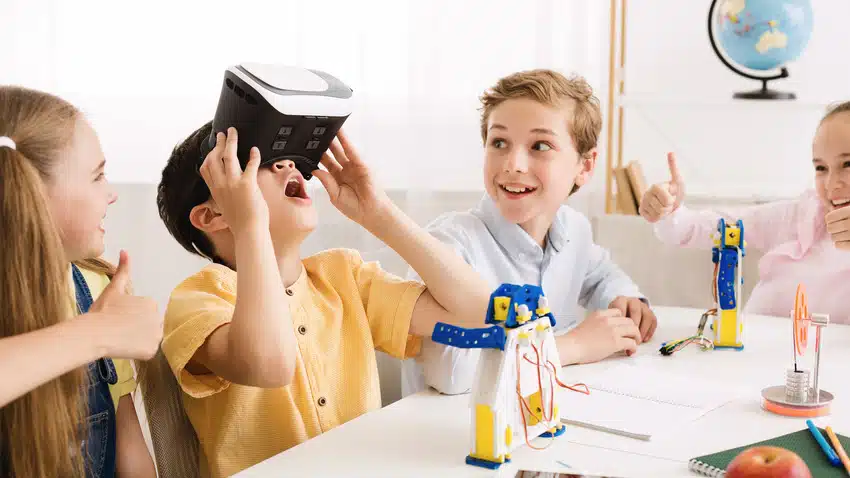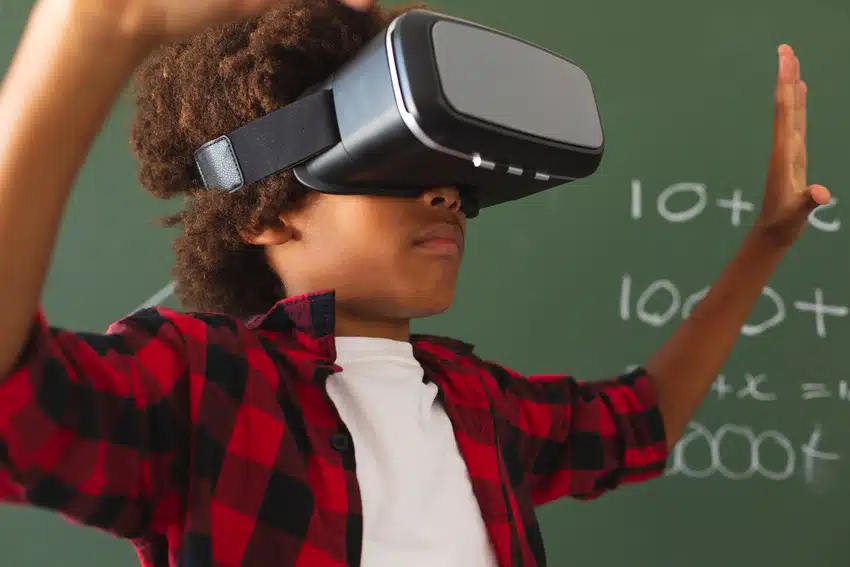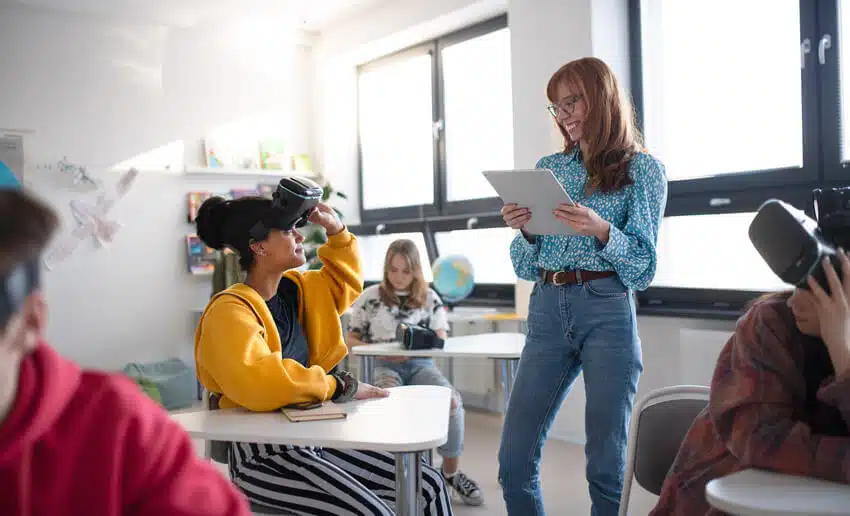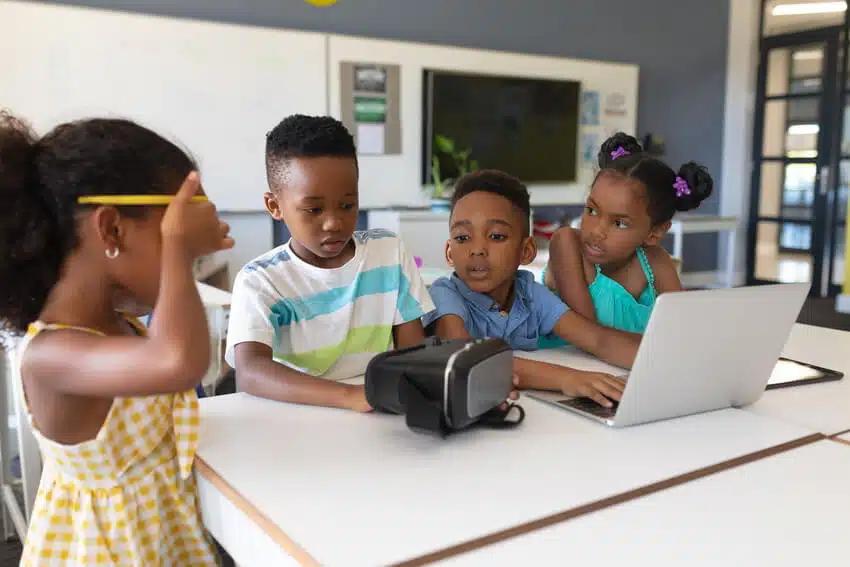
7 Questions to Assess the Health of Your Surveillance & Security Technology
Your surveillance and security systems are only as strong as their weakest component. Outdated hardware, unsupported software, or a lack …

After decades of technological advancement, virtual reality devices have finally surged in popularity during the past few years. This computer technology produces immersive simulated environments that can look, sound, and even feel real. These devices can immerse users in 3D real-world scenes or fantastical surroundings. VR users can travel virtually anywhere, from fictional Mordor to the real-life International Space Station. Educators can easily imagine how they could employ VR in classrooms to make learning more engaging and immersive for students.
The ideas behind virtual reality arose well before computers entered daily life. For instance, a man named Martin Helig developed a mechanical device called the Sensorama in the 1960s, and it engaged sight, sound, touch, and smell. He also designed a Telescope Mask that he described as a wearable TV. The popular View-MasterToy, a stereoscopic simulator, debuted in the 1930s and remained in production until 2008.

The desire for scientific and educational applications fueled a lot of early VR development. By the 1970s, NASA and MIT had created crude virtual maps that allowed users to simulate travel to other planets or locations here on Earth. Several companies, including Sega and Nintendo, introduced virtual reality systems during the 1980s and 90s. However, these room-sized innovations typically cost tens of thousands of dollars and were never meant for at-home use.
The gaming industry introduced VR to the masses as technology improved and became more affordable. The first Oculus Rift headset debuted on Kickstarter for relatively inexpensive donations of at least $300 in 2012. A couple of years later, Sony introduced its first VR headset for the PlayStation 4, and Google released Cardboard, a viewer that worked with Android phones. Facebook purchased Oculus in 2014 for $3 billion.
Since the early days of VR, hundreds of companies have participated in its development. According to EarthWeb:

Virtual reality has been shown to improve students’ performance on knowledge assessments. A study from China demonstrated a 50 percent difference in pass rates between students who learned with immersive VR and those who used traditional teaching methods. Similarly, a study from East Carolina University illustrated that students benefited from VR when learning STEM concepts.
The ability to directly measure and observe increased brain activity in students while learning in virtual reality highlights the potential of this technology to enhance the learning experience. The immersive and engaging nature of virtual reality can create a unique and stimulating learning environment that promotes higher levels of focus, retention, and performance among students.
As virtual reality technology becomes more accessible and affordable, its potential for revolutionizing education is promising. It has the potential to transform the way students learn, making education more interactive, enjoyable, and effective. By leveraging the power of virtual reality to create personalized and adaptive learning experiences, students can engage with the subject matter in a more meaningful way.
S3 Technologies has vetted a number of solutions to deliver state-of-the-art virtual reality solutions for schools that are educationally focused and designed to protect student data privacy. The industry standard for VR use is generally for children over 13 due to student data privacy constraints (CIPA and COPPA) as well as concerns about eyestrain, hand-eye coordination, and brain development. S3 provides 13+ solutions that protect student data privacy (requiring no accounts). For students under the age of 12, S3 offers a number of alternatives that do not require young students to wear adult headsets.
S3 Technologies suggests limiting VR experiences, especially in students under 13, to fifteen minutes a day. Educators should closely supervise all students and set limits on the amount of time spent in virtual classrooms. S3 assists schools with device management and content control to ensure students are only using the headsets for the intended educational purpose. S3 also partners with educators to determine when and where they should integrate VR into their curriculum.
It is crucial to strike a balance between utilizing VR technology as an educational tool and ensuring that young students do not overuse it, considering potential health and developmental concerns. Therefore, implementing time restrictions and supervision by educators can help ensure the responsible and safe use of VR in educational settings, especially for children under 13.

VR has evolved a lot since the first crude mechanical devices. Improvements in technology and accessibility have made these headsets familiar sights in homes, businesses, government organizations, and schools. Most children enjoy age-appropriate immersive virtual reality apps, even educational ones. VR can improve student focus and give educators flexible in-person and remote class options. At S3 Technologies, we help schools all over Ohio integrate the appropriate VR solutions that meet the needs of their classrooms and other educational technology in classrooms. We also work within our customers’ budgets and even help them find and apply for grants. Learn more today about how we effectively provide teacher technology training, tech integration, networking, and security services to make teaching more productive and fun.
VR is revolutionizing education, offering students immersive and interactive learning experiences that were once difficult to imagine. To fully realize its potential, schools must take a strategic approach to integration.
Quality hardware and software are the basis of a successful VR program. Devices like the HTC Vive and Meta Quest headsets stand out due to their high-resolution displays, versatile tracking systems, and compact designs. These features ensure students can engage fully with interactive virtual environments.
Meanwhile, educational VR software like VictoryXR offers content tailored for various subjects, from history to science and even career and technical education (CTE). These applications create engaging virtual classrooms where students can explore complex topics in ways that traditional methods cannot replicate.
Providing hands-on experiences can sometimes be dangerous, impossible, counterproductive, or expensive (DICE). For instance, learning firefighting or surgery involves risk, and aeronautics simulations demand costly equipment.
Lessons that fit the DICE framework are ideal for virtual reality. VR allows students to engage safely, affordably, and effectively in these complex scenarios without real-world limitations, making learning both immersive and practical.
While VR creates fully immersive digital environments, augmented reality provides interactive experiences without removing students from the physical classroom setting. AR overlays digital elements onto the real world, enhancing a user’s perception of their surroundings.
RedboxVR‘s education kits offer high-performance headsets and VR applications tailored for elementary students. One standout platform is ExpeditionsPro, which enables virtual excursions, transforming traditional lessons into captivating educational journeys.
Merge EDU is another excellent resource, allowing students to interact with 3D objects and simulations using AR. This enhances understanding of complex concepts by bringing learning materials to life.
Comprehensive training is essential for educators to effectively integrate VR and AR technologies into their teaching methods. Proper guidance ensures that these tools are used to their fullest potential, enhancing student engagement and learning outcomes.
S3 Technologies offers customized professional development and coaching to help schools seamlessly incorporate VR technology into their curriculums. Our interactive training workshops demonstrate how the technology functions and how to apply it effectively in the classroom. Additionally, S3 provides ongoing support to help educators adapt and ensure a successful and lasting integration.
Content is key to a successful educational VR experience. Schools should take advantage of their VR vendor’s full suite of media assets, ensuring that the educational content aligns with curriculum goals and engages students effectively.
Schools working with S3 gain access to leading AR/VR vendors and their extensive libraries of educational resources. Our collaboration with them provides schools with high-quality, curriculum-aligned media assets, including interactive lessons, virtual field trips, and subject-specific simulations. By leveraging these resources, schools can create engaging, immersive learning experiences tailored to their students’ educational needs.

Your surveillance and security systems are only as strong as their weakest component. Outdated hardware, unsupported software, or a lack …

School safety has never been more important. In an era where timely and effective communication can make all the difference, …

These days, school video productions have become commonplace. Most students own smartphones with cameras, many editing programs are free, and …

“What technology should I buy for my school?” It’s a common question among teachers and administrators—and with good reason. Educational …